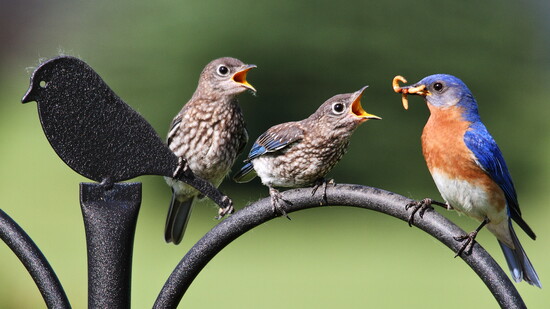Thinking of putting up a bird feeder? You’re not alone. Backyard birding is the second most popular hobby in the U.S.—right behind gardening. Bob Gors of Wild Birds Unlimited in Macomb shares expert tips to help you get started—and get results.
Start with the Right Setup
If you’re new to bird feeding, don’t overcomplicate it. Bob recommends starting with a tray feeder, either pole-mounted or hung. “It’s accessible to the widest range of birds,” he says, “and it lets you experiment with different seed blends.”
Before setting up, take a look at your yard. Birds prefer to feed near trees or shrubs where they can perch and scan for predators. “If your yard is wide open, it’s going to be harder to attract them,” Bob notes.
Quick Tip: Place your feeder about 15 feet from trees or shrubs to give birds a safe place to wait their turn.
Choose the Right Seed—and Skip the Fillers
Not all bird seed is created equal. Bob advises avoiding blends with fillers like milo, wheat, or oats. “Those are agricultural leftovers. Most birds won’t eat them.”
Each Wild Birds Unlimited store owner customizes their seed blends, based on the birds in each store’s specific area. Their blends contain no fillers—just high-quality ingredients birds actually eat. They’re available in no-mess varieties—no shells, no waste. “With standard seed, up to 40% of the weight of the bag is shells,” Bob says. “No-mess is 100 percent pure bird food.”
Quick Tip: Choose fresh, unscented, unflavored seed. Birds don’t need additives—just what they’d eat in nature. Check the ingredients on the bag: sunflower should be the first ingredient—since it’s the seed most birds love.
Keep Unwanted Guests Away
Squirrels causing trouble? Try safflower seed. “It tastes bitter to squirrels but attracts cardinals, grosbeaks, titmice, nuthatches and chickadees,” Bob says. Hot pepper blends also work—birds can’t taste the heat, but mammals can.
To deter large birds like starlings, Bob recommends using a cage around tube feeders to limit access. Tube feeders with small perches help discourage bigger birds. For tidier feeding, seed cylinders—compressed seed—are a great low-mess option.
Quick Tip: “Start simple,” Bob advises. “Watch what’s happening in your yard, then adjust as needed.” Unlike loose seed, cylinders make the birds work harder—and give you longer-lasting views of the birds.
Spot Bird Behavior (and Backyard Drama)
Once your feeder’s up, the show begins.
“Different species act differently,” Bob explains. “Cardinals are typically the first and last birds of the day to the feeder. Male hummingbirds are very territorial and will defend ‘their’ feeder. Chickadees come to the feeder in a flash; they have a grab-and-go strategy. . “In our backyard, orioles and bluebirds battle over live mealworms,” he adds. “The female bluebird often holds her ground.”
Quick Tip: You don’t need to track every species. “Just sit back with a cup of coffee and watch,” Bob says. “You’ll start noticing more than you’d expect.”
Seasonal Changes to Expect
Feeder activity increases in summer, thanks to fledglings. “By July, your bird population has basically doubled,” Bob says. At the same time, some favorites—like male orioles—start their fall migration as early as July.
One common myth? That goldfinches leave in winter. “They stay put,” Bob says. “But the males molt into drab-colored feathers, so people often don’t recognize them.”
Quick Tip: Keep feeding in winter. “Some of the best bird watching happens in the colder months—different species of birds visit us in the winter.”
How to Attract Specific Birds
Want cardinals? Use tray feeders or tube feeders with U-shaped perches. “They’re heavier birds,” Bob says. “Standard tube feeders are hard for them to use.”
Hoping for bluebirds? They prefer park-like settings. If your yard fits, try a nesting box with a 1.5-inch entrance, and offer live mealworms far away from the nest box.
Hummingbirds? Stick to sugar water—no red dye needed. “And expect a show,” Bob adds. “Males are fiercely territorial at the feeder.”
Wild Birds Unlimited carries feeders tailored to specific birds, but Bob and his team focus on fit. “We ask about your yard, your goals, and guide you from there.”
Quick Tip: Not sure what birds are in your area? Ask your local Wild Birds Unlimited shop or check with the Macomb Audubon Society.
Why Bird Watching Sticks
Bob says many customers started birding during the pandemic—and never stopped. “They looked out the window and realized something was there,” he says. It’s remained part of their lives: one couple told Bob they still start every morning on the porch with coffee and birdsong. “It became a ritual that many people now cherish,” Bob says.
For expert help making bird watching your ritual, stop by Wild Birds Unlimited in Macomb or visit wbu.com/macomb
“You don’t have to track every species—just pour a coffee and watch. The birds will tell you plenty.”
“Most people start with one feeder and get hooked. It becomes part of the day—peaceful, fascinating, and surprisingly personal. You’ll start to recognize personalities in the birds themselves.”
